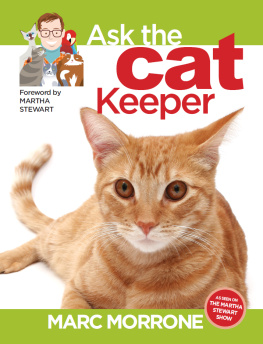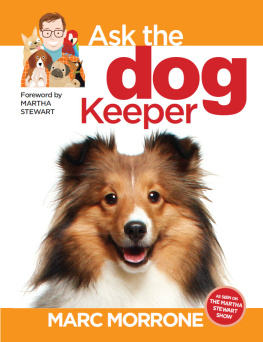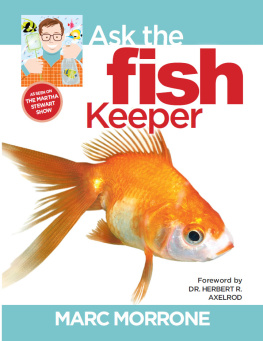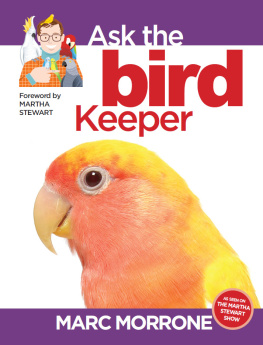Original illustrations 2009 by Jason OMalley. Photographs 2009 by Tara Darling and Isabelle Franais.
Special thanks to the authors two veterinarians, Dr. Jonathan May and Dr. Brian Marder, and to the staff of Cat Fancy for reviewing the text and photographs of this book.
Copyright 2009 by I-5 Press
All rights reserved. No part of this book may be reproduced, stored in a retrieval system, or transmitted in any form or by any means, electronic, mechanical, photocopying, recording, or otherwise, without the prior written permission of I-5 Press, except for the inclusion of brief quotations in an acknowledged review.
Library of Congress Cataloging-in-Publication Data
Morrone, Marc, 1960
[Ask the cat keeper]
Marc Morrones ask the cat keeper / by Marc Morrone with Amy Fernandez.
p. cm.
ISBN 978-1-933958-30-9
eISBN 978-1-937049-93-5
1. CatsMiscellanea. 2. CatsHealthMiscellanea. 3. CatsBehaviorMiscellanea. I. Fernandez, Amy. II. Title. III. Title: Ask the cat keeper.
SF447.M69 2009
636.8dc22
2009009827
I-5 Press
A Division of I-5 Publishing, LLC
3 Burroughs
Irvine, California, 92618
Printed and bound in China
16 15 14 13 12 11 10 2 3 4 5 6 7 8 9 10
CONTENTS

To Rocky,
who was a teeny-weeny little cat yet
brought a great deal of comfort to me
in a dark time of my life.
FOREWORD
BY MARTHA STEWART
I was a cat lover before I loved dogs.
At a country fair in Woodstock, New York, someone had a basket of longhair cats, and I chose the darkest kitty with the longest hair and named it Chigi after one of the Italian popes. Never having owned a cat before, I took it home to our big apartment on Riverside Drive in New York City, where it quickly ingratiated itself into our lives. It was playful, it fetched and returned little stuffed toys, and it answered the telephone each time it rang, knocking the receiver off the hook and meowing a big hello to anyone on the line.
Chigi died at about five from cancer, but I quickly adopted another longhair that was also part Persian.
Chigi II was also a phenomenal cat, and she made the move with us to Westport, Connecticut, and made her home with us at Turkey Hill, wandering in and out of the house, traveling in our car wherever we traveled. She loved to hunt and loved to please, and she loved fresh raw beef kidney chopped into small pieces.
After the two Chigis, I discovered Persians and then Himalayans. I found that I really got along very well with the flattish-faced, longhair, colorful, fluffy, and gently friendly breeds that loved attention but did not demand it, respected the furniture, and coexisted nicely with the dogs, family, and friends. I started with one and kept adding until at one time we housed nine cats at Turkey Hill in Westport. If cats are well groomed, cared for sensibly by the veterinarian, and fed very well, they can live for more than twenty years. All of the beauties that are with me now are over twelve except for the newest addition, Sir Frost, who was adopted at ten, and all go outside every day, eat well, and sleep in baskets, on cushions, and on chairs or beds all over the house. Each also answers to its name and comes (usually) when called. I personally comb and groom them once a week on Sunday, but they are also groomed during the week by others. Ears are cleaned and teeth checked for tartar buildup, and gums are checked for problems.
Cats are so very less demanding of attention than dogs are, but they crave petting, conversation, and love despite their more aloof attitudes. The excellent advice Marc Morrone gives in this book will help anyone with cats enjoy pet ownership even more. And possibly you will add more cats to your life, as I have done, keeping vitality and charm and interest in your household.
All of the Cats I Have Owned:
Chigi Totoadopted in Woodstock, NY
Chigi Toto IIadopted from Bide-a-Wee home
New kittyadopted from Molly Vogel
China catadopted from Florida
Uncle Vanyablue Persian, ASPCA
Uncle Vanya IIblue Persian, ASPCA
Magnoliasilver Persian, adopted
Teenyblue point Himalayan, adopted
Weenylavender point Himalayan, adopted
Mozartlynx Himalayan, aged 18
Beethovenflame point Himalayan
Bartokseal point Himalayan, aged 17
Berliozflame point Himalayan
VerdiHimalayan, aged 12
VivaldiHimalayan, aged 12
Elektralynx Himalayan, given away
Siriuslynx Himalayan
Sir Frostblue point Himalayan, adopted, aged 10
Lady SnowHimalayan, adopted but returned


INTRODUCTION
The cat is the pet of contrast. Consider that the words dog and domesticated both begin with the letter d; the dog is the most domesticated animal in the world. The late, great Roger Caras defined the dog as a species whose genes are controlled by man. However, the words cat and contrast both begin with the letter c, and a cat is definitely a contrast between a wild and a domesticated animal. The cat is the only domesticated animal that voluntarily chooses this state. In the course of an hour, a cat can change from a pampered pet dozing contentedly on a fluffy pillow in the living room to a steely-eyed killer crouching in the underbrush, stalking small birds and rodents. Then, just as quickly, he can walk back into the role of pampered pet. No other domesticated animal can do this. Some, such as goats and pigs, can choose to live in a feral state, but once they are totally feral they will never revert to a domesticated state. Only the cat can live in both worlds. If the human race vanished, so would dogs. Cats would continue as long as there were mice to catchand there will always be mice!

Human opinions toward cats are another outstanding source of contrast. Some humans value cats as family members. At the same time, cats are hated and vilified by others. To this day, some of my own relatives believe that a cat will suck a babys breath away. Throughout history, cats have experienced treatment ranging from deification by the ancient Egyptians to being burned alive as agents of Satan by Medieval Europeans. And the cats themselves never did anything to specifically attract adulation or persecution; they have simply been cats.
Perhaps because it is generally believed that cats have not been domesticated as long as dogs have (less than 10,000 years), we have not yet come to understand what a cat truly is. The domesticated cat has changed very little from its wild ancestor, the North African wild catthere are perhaps only small variations in size, coat length, color, and ear shape. The only taxonomic variation is that the domestic cat can come into heat multiple times a year, whereas the North African wild cat comes into heat once a year. The biggest difference between wild and domestic cats is in their behavior. When a wild cat reaches adolescence, the family unit breaks up and each cat lives independently as an adult; individuals interact only during mating season. In contrast, adult domestic cats voluntarily seek attention from not only humans but also other species in the household. The interesting thing is that cats do this by choice. Dogs are genetically programmed to respond this way, thanks to thousands of years of selective breeding. The same cannot be said for cats. Humans kept cats around because they were useful to help control rats and mice, but historically no one made any effort to selectively instill particular temperament traits in the cat.
Next page













